A massive coal mine that was a key platform in Queensland Premier Annastacia Palaszczuk's election campaign gained approvals despite the environmental regulator raising serious concerns behind the scenes about lasting impacts on surrounding waterways, ABC Investigations can reveal.
Pembroke Resources has received approval for a coking coal mine south-west of Moranbah in central Queensland that will straddle the Isaac River and impact on almost 4,000 hectares of floodplain.
The Olive Downs mine will be the third largest in the state, producing up to 15 million tonnes a year and employing 1,500 people.
Pembroke wants more than 1,000 hectares of Paul Harris's grazing property, Old Bombandy, for the mine.
Mr Harris owns a prime Wagyu beef operation that runs more than 7,000 head of cattle on the farm.
"It's going to reduce greatly the supply of water in the river," said Mr Harris, who uses water from the Isaac River for his stock.
ABC News: Christopher Gillette
)Right to Information documents obtained by ABC Investigations show the Department of Environment and Science was also concerned.
They reveal the department repeatedly warned the then-coordinator-general during the environmental approval process in 2018 and 2019 of the serious risks of leaving huge mine pits — also called "voids" — on the Isaac River floodplain after the mine is closed.
In letters and submissions, the department said the voids would permanently draw groundwater into them, reduce river water, permanently alter the floodplain and change flood velocities.
ABC News: Christopher Gillette
)It said the ongoing impacts on the groundwater, the nearby Isaac River and floodplain had not been sufficiently assessed.
The company is also seeking to use a vast section of a grazing property managed by Roy Rogers for the mine.
Mr Rogers said any impacts on the river system could devastate their cattle operation.
"Because it affects people like us on the bottom line that are raising cattle, that's our livelihood," he said.
ABC News: Christopher Gillette
)Environmental regulator raises concerns about plan to leave voids on floodplain
Pembroke Resources plans to leave three large voids on the Isaac River floodplain after the mine has closed, including one on the grazing property managed by Mr Rogers and owned by Queensland businessman Jim Gorman.
Queensland's history of environmental disasters caused by mine voids on floodplains led to a recent state ban on leaving them after a mine was closed.
But the ban does not apply to Pembroke and several other mines in Queensland because they started their environmental applications before the laws came into effect in November 2019.
ABC News: Mark Doman
)The then-coordinator-general Barry Broe oversaw the company's environmental approval process and received advice from various government departments.
Right to Information documents reveal that in October 2018 the Department of Environment and Science expressed serious concerns about the company's draft Environmental Impact Statement (EIS).
In a letter to Mr Broe, it said it "considers the work completed to date by Pembroke Resources to be insufficient in detail and lacking the necessary commitments in relation to the rehabilitation of these voids".
Supplied
)Its submission detailed concerns that the company failed to properly assess the impact of the voids on the groundwater and ecosystems that rely on it, the Isaac River, the flood risks on neighbouring properties, how they would be rehabilitated and justify why it should be allowed to leave them on the floodplain at all.
Hydrologist Matt Currell has examined ABC Investigations' Right to Information documents.
The documents show the department sought extra information on Pembroke's plan for ensuring the safety and stability of the voids in the long term.
ABC News: Sarah Curnow
)"That sort of information is really needed before a clear decision can be made that the environmental effects of this mine are able to be managed properly," he said.
"There was [also] concern raised by the department that leaving those mine voids there would cause this long-term ongoing seepage of water from the river that would reduce flows in the river as well as affecting the ecosystems and water users that depend on groundwater in the area."
In May 2019, the department again wrote to the coordinator-general, this time in response to Pembroke's final EIS.
Supplied
)It found Pembroke's proposal to build permanent rock waste emplacements and leave "final voids" was lacking in information and did not demonstrate it would meet "the government's expectations and best practice environmental management".
It said the residual risk was high and the rehabilitation conditions Pembroke suggested for the final environment permit were "unacceptable".
Supplied
)Ten days later, and after meeting with the department's director-general Jamie Merrick, the coordinator-general gave his environmental approval for the mine despite the concerns.
In an email to Mr Merrick, the coordinator-general said: "Our conclusion is that the impacts are manageable and stringent conditions have been formulated to ensure this outcome occurs."
"Disturbed areas would be rehabilitated to be safe, stable, non-polluting and able to sustain identified land uses," he wrote.
Supplied
)The department later granted the final state environmental approval by issuing the company its environmental authority with conditions.
Managing lawyer of the Environmental Defenders Office in Queensland, Revel Pointon, believes the correspondence reveals major flaws in the environmental approval process in the state.
"It's highly concerning that the coordinator-general is ignoring that [the department's] advice and going ahead and providing for recommendations of approval around a mine such as this," she said.
"This really does raise serious questions around the wasted resources of the experts in the Department of Environment and Science.
Farm manager Roy Rogers said the case did not give him much faith in the environmental approval process.
"Not much faith at all … they've got to do their homework," Mr Rogers said.
"Everybody up and down that river that's grazing stock needs that river to draw water to supplement their cattle."
ABC News: Christopher Gillette
)Mr Rogers is concerned about impacts to the water levels under the riverbed where they pump from due to the seasonal nature of the Isaac River.
"If it impacts the underground water levels in the river, it could cause all sorts of problems," Mr Rogers said.
Fellow grazier Paul Harris agrees.
"At the moment it's got water in it. Most of the year it normally doesn't have water in it, it's just sand … when it's really dry, our water supply is hard to find."
ABC News: Christopher Gillette
)Pembroke Resources and the current and former coordinator-generals all declined to be interviewed.
In a statement, Pembroke Resources said: "Olive Downs will engage in more modern progressive rehabilitation reducing the impact of workings throughout the life of the mine and the final voids will be engineered to protect surrounding areas."
The current coordinator-general, Toni Power, said additional information was sought from Pembroke in relation to the Department of Environment and Science requests in October 2018 and May 2019, including on groundwater, groundwater ecosystems and flood risks to neighbouring properties.
"All impacts were assessed on merit and conditions were included in the evaluation report that he [the former coordinator-general] regarded as appropriate to ensure that, post-mining, the land will be stable, safe and non-polluting," Ms Power said.
"Subsequent to the May 2019 submission from the Department of Environment and Science, the-then coordinator-general sought further information from the proponent in relation to the proposal to leave final voids and waste rock emplacements."
She said the additional information provided was considered by the-then coordinator-general prior to his recommendation of approval and the company's proposed rehabilitation conditions were consistent with regulations.
The Department of Environment and Science said the final environmental authority included "strict conditions imposed by the coordinator-general" on how the voids would be rehabilitated.
However groundwater hydrologist Matt Currell said those conditions were vague and a lot of the detailed work to understand the voids' impacts had been deferred to a later date.
"It's only after approval is given that the mining company has to produce detailed plans for how it's going to manage and monitor some of these really important environmental impacts," he said.
Mining lease approvals come after a busy August
The next step for Pembroke was gaining mining lease approvals, which are decided personally by the state mining minister, who was Anthony Lynham at the time.
In 2018, the company engaged a lobbying firm called Next Level Strategic Services.
One of the firm's two directors is high-profile Labor figure Cameron Milner, a former Queensland state secretary and previous chief of staff to Bill Shorten.
Supplied
)Contact logs analysed by ABC Investigations show that in August alone Next Level Strategic Services secured 11 discussions about Pembroke's project with the chiefs of staff of Mr Lynham and Treasurer Cameron Dick.
One month later, and just days before last year's state election was called, Mr Lynham approved the mining leases.
Premier Annastacia Palaszczuk announced the Pembroke approval surrounded by TV cameras on a mine site.
ABC News
)However, it soon emerged that as well as his firm lobbying the Palaszczuk government, Mr Milner was also working for Labor's state election campaign.
Transparency International CEO Serena Lillywhite said this raised potential integrity concerns.
ABC News: Kyle Harley
)The Premier, Treasurer, Mr Milner, and former mining minister Mr Lynham all declined to be interviewed, providing written statements instead.
A spokesman for the Palaszczuk government said a Labor government introduced the current lobbying code of conduct.
"Lobbyists are required to follow the code at all times and ensure appropriate disclosures are made. Perceived or potential conflicts are appropriately dealt with."
ABC News
)The spokesman for the Treasurer Cameron Dick said: "Neither the Treasurer nor the Treasury has any role in the granting of a mining lease."
Mr Milner said all work for clients adhered to the Queensland Integrity Act, including declaring lobbying contacts publicly.
"Any ALP activity is done as an ALP member of 30 years, on an unpaid basis and having been involved in every Queensland state election since 1992," he said.
Graziers await Supreme Court ruling on mining leases
Grazier Paul Harris believes the timing of the approval was political.
He and Jim Gorman objected to the mining leases over water impacts, which meant the case went to the Land Court. However, the court recommended the approval in July last year.
Mr Harris has appealed against the decision in a judicial review to the Supreme Court and is awaiting the outcome.
ABC News: Christopher Gillette
)Three mining leases have been approved so far, with the two that cover Paul Harris and Jim Gorman's properties yet to be approved by the minister.
He is angry the mining leases were approved despite outstanding court action.
"You can have checks and balances, but if they're all ignored, well, it's not going to do anything is it?" he said.
Pembroke Resources said the mining leases were granted after more than "four years of detailed environmental, technical and engineering work including wide consultation with a diverse range of stakeholders".
The current Mining Minister Scott Stewart said: "It's not uncommon to have objectors to mining leases and environmental authority applications."
"Objectors are able to seek judicial reviews of the land court recommendations which recommend the granting of leases."







